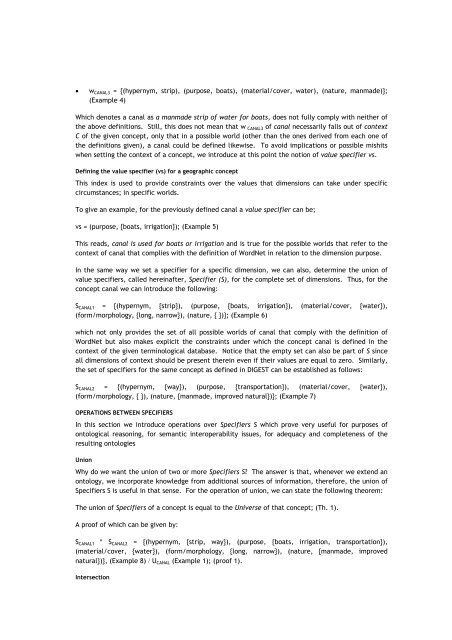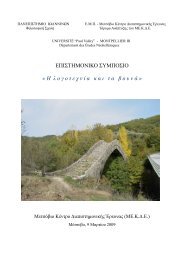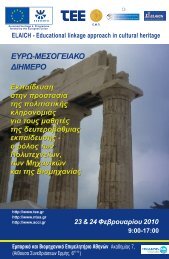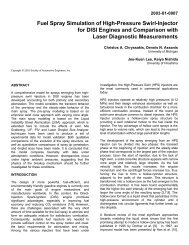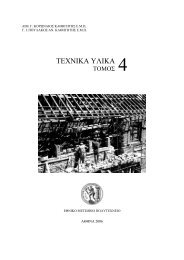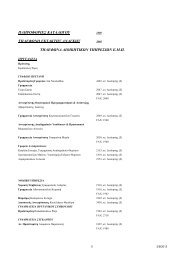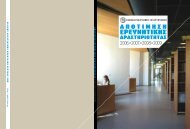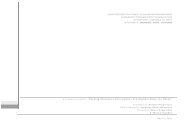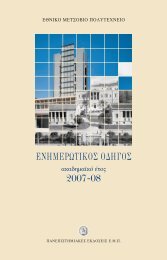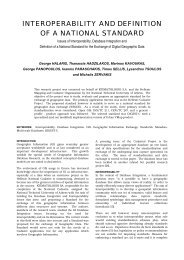CONTEXT IN GEOGRAPHIC KNOWLEDGE REPRESENTATION
CONTEXT IN GEOGRAPHIC KNOWLEDGE REPRESENTATION
CONTEXT IN GEOGRAPHIC KNOWLEDGE REPRESENTATION
Create successful ePaper yourself
Turn your PDF publications into a flip-book with our unique Google optimized e-Paper software.
• w CANAL3 = {(hypernym, strip), (purpose, boats), (material/cover, water), (nature, manmade)};(Example 4)Which denotes a canal as a manmade strip of water for boats, does not fully comply with neither ofthe above definitions. Still, this does not mean that w CANAL3 of canal necessarily falls out of contextC of the given concept, only that in a possible world (other than the ones derived from each one ofthe definitions given), a canal could be defined likewise. To avoid implications or possible mishitswhen setting the context of a concept, we introduce at this point the notion of value specifier vs.Defining the value specifier (vs) for a geographic conceptThis index is used to provide constraints over the values that dimensions can take under specificcircumstances; in specific worlds.To give an example, for the previously defined canal a value specifier can be;vs = (purpose, {boats, irrigation}); (Example 5)This reads, canal is used for boats or irrigation and is true for the possible worlds that refer to thecontext of canal that complies with the definition of WordNet in relation to the dimension purpose.In the same way we set a specifier for a specific dimension, we can also, determine the union ofvalue specifiers, called hereinafter, Specifier (S), for the complete set of dimensions. Thus, for theconcept canal we can introduce the following:S CANAL1 = {(hypernym, {strip}), (purpose, {boats, irrigation}), (material/cover, {water}),(form/morphology, {long, narrow}), (nature, { })}; (Example 6)which not only provides the set of all possible worlds of canal that comply with the definition ofWordNet but also makes explicit the constraints under which the concept canal is defined in thecontext of the given terminological database. Notice that the empty set can also be part of S sinceall dimensions of context should be present therein even if their values are equal to zero. Similarly,the set of specifiers for the same concept as defined in DIGEST can be established as follows:S CANAL2 = {(hypernym, {way}), (purpose, {transportation}), (material/cover, {water}),(form/morphology, { }), (nature, {manmade, improved natural})}; (Example 7)OPERATIONS BETWEEN SPECIFIERSIn this section we introduce operations over Specifiers S which prove very useful for purposes ofontological reasoning, for semantic interoperability issues, for adequacy and completeness of theresulting ontologiesUnionWhy do we want the union of two or more Specifiers S? The answer is that, whenever we extend anontology, we incorporate knowledge from additional sources of information, therefore, the union ofSpecifiers S is useful in that sense. For the operation of union, we can state the following theorem:The union of Specifiers of a concept is equal to the Universe of that concept; (Th. 1).A proof of which can be given by:S CANAL1″ S CANAL2 = {(hypernym, {strip, way}), (purpose, {boats, irrigation, transportation}),(material/cover, {water}), (form/morphology, {long, narrow}), (nature, {manmade, improvednatural})}, (Example 8) / U CANAL (Example 1); (proof 1).Intersection


